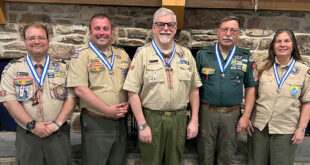The U.S. Department of Health & Human Services designates April as National Child Abuse Prevention Month to recognize “the importance of families and communities working together … to prevent child abuse and neglect.”
This makes April a good time to have some crucial conversations with your children with the help of the youth protection-themed booklets in the handbooks of every BSA program.
The first thing you need to know: These BSA youth protection-themed-booklets are a tool for all of Scouting’s parents. Because the BSA knows how important this conversation is, reviewing these pamphlets with your children is part of the BSA’s advancement requirements.
For example, Requirement No. 7 of the Bobcat badge, the first badge a Cub Scout of any age (except Lions) earns when they join the BSA, reads: “With your parent or guardian, complete the exercises in the pamphlet How to Protect Your Children From Child Abuse: A Parent’s Guide.”
That requirement is repeated for every Cub Scout rank from Tigers to Arrow of Light. Then, to earn the rank of Scout, the first rank earned in Scouts BSA, you’ll have to complete requirement No. 6, which refers youth and their families to the parent’s guide written with older kids in mind.
What makes these books so important?
It says it right there in the introduction:
The following information is offered to help your family establish and maintain a safe environment where you can prevent your child or another child from being abused.
What it’s about
Abuse and neglect can be difficult topics to discuss with your children.
But research shows that children whose parents talk to them about preventing abuse are better able to protect themselves and are more likely to tell if they are experiencing abuse or have been abused in the past.
Full disclosure: I am the father of a child (now a young man) who started as a Tiger and advanced through the rank of Scout and beyond. We went through the activities and discussions in the parent’s guides multiple times. If we can do it, you can, too.
The booklets are organized and written with the goal of opening the door to this difficult discussion.
The first section contains information for parents about child abuse and some tips for talking with your child about child abuse. The second section features discussion exercises for you and your child to do together.
These exercises will help you discuss topics such as:
- Why your child should check with you before going anywhere with another person.
- Choosing the trusted adults your child can turn to.
- Understanding our personal boundaries.
- What your child should do if someone asks them to keep a secret.
Why it’s worth it
In the end, the parents’ guides encourage the idea that this conversation is the first step toward what should be a long and healthy dialogue within your family about personal safety awareness. In future posts this month, we’ll share additional resources you can use as you continue these discussions.
Maybe the most significant takeaway from this whole thing? The topics and exercises in the parent’s guides, along with the rules, regulations and requirements described in the BSA’s Barriers of Abuse, can provide valuable knowledge and safeguards for every family member who takes part in any group activity, inside or outside of Scouting.
These vital conversations can help our children — and each of us — be more prepared to recognize, respond to and report child abuse.
This post was originally published on the Bryan on Scouting blog on April 6, 2022.
 ARCHIVE – New Birth of Freedom Council, BSA Website for the New Birth of Freedom Council, BSA
ARCHIVE – New Birth of Freedom Council, BSA Website for the New Birth of Freedom Council, BSA

